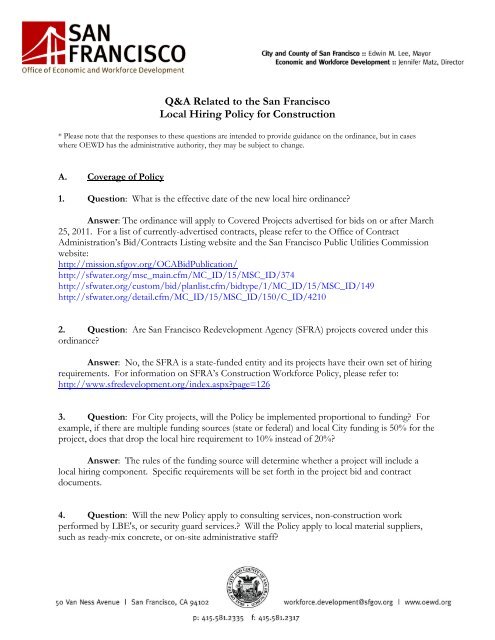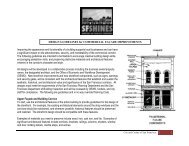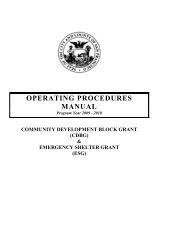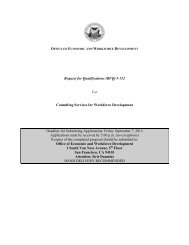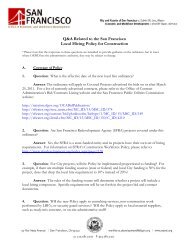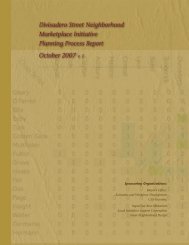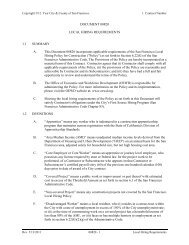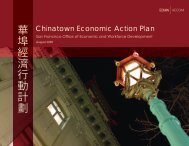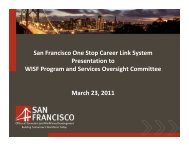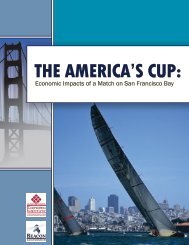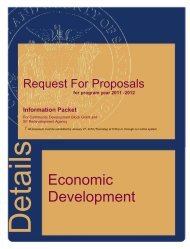Q&A Related to the San Francisco Local Hiring Policy for Construction
Q&A Related to the San Francisco Local Hiring Policy for Construction
Q&A Related to the San Francisco Local Hiring Policy for Construction
You also want an ePaper? Increase the reach of your titles
YUMPU automatically turns print PDFs into web optimized ePapers that Google loves.
Q&A <strong>Related</strong> <strong>to</strong> <strong>the</strong> <strong>San</strong> <strong>Francisco</strong><br />
<strong>Local</strong> <strong>Hiring</strong> <strong>Policy</strong> <strong>for</strong> <strong>Construction</strong><br />
* Please note that <strong>the</strong> responses <strong>to</strong> <strong>the</strong>se questions are intended <strong>to</strong> provide guidance on <strong>the</strong> ordinance, but in cases<br />
where OEWD has <strong>the</strong> administrative authority, <strong>the</strong>y may be subject <strong>to</strong> change.<br />
A. Coverage of <strong>Policy</strong><br />
1. Question: What is <strong>the</strong> effective date of <strong>the</strong> new local hire ordinance?<br />
Answer: The ordinance will apply <strong>to</strong> Covered Projects advertised <strong>for</strong> bids on or after March<br />
25, 2011. For a list of currently-advertised contracts, please refer <strong>to</strong> <strong>the</strong> Office of Contract<br />
Administration’s Bid/Contracts Listing website and <strong>the</strong> <strong>San</strong> <strong>Francisco</strong> Public Utilities Commission<br />
website:<br />
http://mission.sfgov.org/OCABidPublication/<br />
http://sfwater.org/msc_main.cfm/MC_ID/15/MSC_ID/374<br />
http://sfwater.org/cus<strong>to</strong>m/bid/planlist.cfm/bidtype/1/MC_ID/15/MSC_ID/149<br />
http://sfwater.org/detail.cfm/MC_ID/15/MSC_ID/150/C_ID/4210<br />
2. Question: Are <strong>San</strong> <strong>Francisco</strong> Redevelopment Agency (SFRA) projects covered under this<br />
ordinance?<br />
Answer: No, <strong>the</strong> SFRA is a state-funded entity and its projects have <strong>the</strong>ir own set of hiring<br />
requirements. For in<strong>for</strong>mation on SFRA’s <strong>Construction</strong> Work<strong>for</strong>ce <strong>Policy</strong>, please refer <strong>to</strong>:<br />
http://www.sfredevelopment.org/index.aspx?page=126<br />
3. Question: For City projects, will <strong>the</strong> <strong>Policy</strong> be implemented proportional <strong>to</strong> funding? For<br />
example, if <strong>the</strong>re are multiple funding sources (state or federal) and local City funding is 50% <strong>for</strong> <strong>the</strong><br />
project, does that drop <strong>the</strong> local hire requirement <strong>to</strong> 10% instead of 20%?<br />
Answer: The rules of <strong>the</strong> funding source will determine whe<strong>the</strong>r a project will include a<br />
local hiring component. Specific requirements will be set <strong>for</strong>th in <strong>the</strong> project bid and contract<br />
documents.<br />
4. Question: Will <strong>the</strong> new <strong>Policy</strong> apply <strong>to</strong> consulting services, non-construction work<br />
per<strong>for</strong>med by LBE's, or security guard services.? Will <strong>the</strong> <strong>Policy</strong> apply <strong>to</strong> local material suppliers,<br />
such as ready-mix concrete, or on-site administrative staff?
Answer: No, <strong>the</strong> <strong>Policy</strong> does not apply <strong>to</strong> <strong>the</strong> services identified in <strong>the</strong> question. The <strong>Policy</strong><br />
applies only <strong>to</strong> construction work per<strong>for</strong>med under a covered public work or improvement contract<br />
awarded under Chapter 6 of <strong>the</strong> <strong>San</strong> <strong>Francisco</strong> Administrative Code.<br />
5. Question: Are supervisory hours included as Project Work Hours under <strong>the</strong> <strong>Policy</strong>? What<br />
about <strong>for</strong>eman who do not work with <strong>to</strong>ols, are <strong>the</strong>ir hours included as Project Work Hours?<br />
Answer: If a contrac<strong>to</strong>r is required <strong>to</strong> capture a supervisor's or <strong>for</strong>eman's hours through<br />
certified payroll in reporting construction hours per<strong>for</strong>med, <strong>the</strong>n those hours will be counted <strong>to</strong>ward<br />
<strong>the</strong> local hire requirement. For fur<strong>the</strong>r clarification, please contact <strong>the</strong> Office of Labor Standards<br />
En<strong>for</strong>cement.<br />
6. Question: How does <strong>the</strong> <strong>Policy</strong> apply <strong>to</strong> a Covered Project with an awarded contract<br />
amount of $500,000, where <strong>the</strong> prime contrac<strong>to</strong>r self-per<strong>for</strong>ms $100,000 of work and<br />
subcontrac<strong>to</strong>rs have subcontracts valued at $100,000 each? Would <strong>the</strong> subcontrac<strong>to</strong>rs be excluded<br />
from <strong>the</strong> local hiring requirements because each subcontract is less than $400,000, or would both <strong>the</strong><br />
prime contrac<strong>to</strong>r and subcontrac<strong>to</strong>rs be required <strong>to</strong> comply because <strong>the</strong> <strong>to</strong>tal project cost exceeds<br />
$400,000?<br />
Answer: The project in <strong>the</strong> example is a Covered Project because <strong>the</strong> contract amount<br />
exceeds <strong>the</strong> applicable Threshold Amount ($400,000). The contrac<strong>to</strong>r will be responsible <strong>for</strong><br />
ensuring compliance with <strong>the</strong> local hiring requirement <strong>for</strong> Project Work Hours within each trade<br />
per<strong>for</strong>med by contrac<strong>to</strong>r and all subcontrac<strong>to</strong>rs. Contrac<strong>to</strong>r will be responsible <strong>for</strong> working with its<br />
subcontrac<strong>to</strong>rs <strong>to</strong> ensure overall compliance with <strong>the</strong> local hiring requirement. The City will not<br />
en<strong>for</strong>ce <strong>the</strong> local hiring requirements of <strong>the</strong> <strong>Policy</strong> directly against <strong>the</strong> subcontrac<strong>to</strong>rs because <strong>the</strong><br />
subcontract amounts are less than <strong>the</strong> Threshold Amount.<br />
7. Question: If a Covered Project has, <strong>for</strong> example, 10 subcontrac<strong>to</strong>rs with subcontracts<br />
valued in excess of $400,000, and 30 subcontrac<strong>to</strong>rs with subcontracts valued at less than $400,000,<br />
is <strong>the</strong> Prime Contrac<strong>to</strong>r responsible <strong>for</strong> overall compliance with <strong>the</strong> local hiring requirement, or only<br />
required <strong>to</strong> comply with respect <strong>to</strong> Project Work Hours self-per<strong>for</strong>med by <strong>the</strong> Prime?<br />
Answer: In this example, <strong>the</strong> prime contrac<strong>to</strong>r will be responsible <strong>for</strong> overall compliance<br />
with <strong>the</strong> local hiring requirement <strong>for</strong> Project Work Hours within each trade per<strong>for</strong>med by Prime<br />
Contrac<strong>to</strong>r and all Subcontrac<strong>to</strong>rs. The City will have <strong>the</strong> authority <strong>to</strong> en<strong>for</strong>ce <strong>the</strong> local hiring<br />
requirements of <strong>the</strong> <strong>Policy</strong> directly against those Subcontrac<strong>to</strong>rs with subcontracts with values in<br />
excess of $400,000.<br />
8. Question: Can apprenticeship school time be included in project hours?<br />
Answer: No, only <strong>the</strong> construction trades hours that will be reported on certified payroll can<br />
be counted <strong>to</strong>wards project hours.<br />
Last Updated 3-18-11 2
B. <strong>Local</strong> <strong>Hiring</strong> Plan<br />
1. Question: At what point will a contrac<strong>to</strong>r need <strong>to</strong> submit <strong>the</strong> <strong>Local</strong> <strong>Hiring</strong> Plan that is<br />
referenced in <strong>the</strong> ordinance? What will <strong>the</strong> plan need <strong>to</strong> do in order <strong>to</strong> be approved by OEWD?<br />
Answer: If a prime contrac<strong>to</strong>r is awarded <strong>the</strong> contract on a Covered Project that is estimated<br />
<strong>to</strong> cost $1 million or more, <strong>the</strong>n <strong>the</strong> prime must submit a <strong>Local</strong> <strong>Hiring</strong> Plan <strong>to</strong> OEWD and <strong>the</strong><br />
awarding department within 15 days from <strong>the</strong> date of <strong>the</strong> award. The prime contrac<strong>to</strong>r will be<br />
responsible <strong>for</strong> collecting in<strong>for</strong>mation <strong>for</strong> <strong>the</strong> <strong>Local</strong> <strong>Hiring</strong> Plan from subcontrac<strong>to</strong>rs.<br />
All in<strong>for</strong>mation will be submitted through <strong>the</strong> City’s online project reporting system (currently <strong>the</strong><br />
Elation Systems). The <strong>Local</strong> <strong>Hiring</strong> Plan will be approved if <strong>the</strong> <strong>for</strong>m is fully completed, and<br />
identifies what resources <strong>the</strong> contrac<strong>to</strong>r and its subcontrac<strong>to</strong>rs will utilize <strong>to</strong>wards meeting <strong>the</strong><br />
required <strong>San</strong> <strong>Francisco</strong> resident hours.<br />
C. Disadvantaged Worker<br />
1. Question: Are <strong>the</strong>re penalties <strong>for</strong> not meeting <strong>the</strong> disadvantaged worker goal?<br />
Answer: While <strong>the</strong> disadvantaged worker participation is a requirement in <strong>the</strong> ordinance, it is<br />
not subject <strong>to</strong> financial penalties.<br />
2. Question: What household size is being used <strong>for</strong> this legislation <strong>for</strong> <strong>the</strong> purposes of<br />
determining disadvantaged worker status?<br />
Answer: The Area Median Income (AMI) is one of <strong>the</strong> standards <strong>for</strong> determining<br />
disadvantaged worker status. At <strong>the</strong> time of commencing work, if a worker’s household income is<br />
less than 80% of <strong>the</strong> AMI, <strong>the</strong> worker will be considered disadvantaged. The AMI is derived from<br />
<strong>the</strong> Department of Housing and Urban Development (HUD) and is adjusted <strong>for</strong> household size.<br />
For in<strong>for</strong>mation about <strong>the</strong> AMI <strong>for</strong> <strong>San</strong> <strong>Francisco</strong>, please refer <strong>to</strong> HUD’s website:<br />
http://www.huduser.org/portal/datasets/il.html<br />
3. Question: Are all of <strong>the</strong> neighborhoods listed in <strong>the</strong> description in 6.22(G)(1)(m) currently<br />
at an excess of 150% of <strong>the</strong> City Unemployment rate?<br />
Answer: The neighborhoods listed in <strong>the</strong> ordinance are examples of distressed<br />
neighborhoods in <strong>San</strong> <strong>Francisco</strong>, but not all residents of those neighborhoods will be considered a<br />
disadvantaged worker. Note that <strong>the</strong> "rate of unemployment in excess of 150%" criterion applies <strong>to</strong><br />
census tracts within <strong>the</strong> City.<br />
4. Question: Can an individual with a household income significantly above AMI who resides<br />
in a census tract within <strong>the</strong> City with a rate of unemployment in excess of 150% of <strong>the</strong> City<br />
unemployment rate qualify as a disadvantaged local hire?<br />
Last Updated 3-18-11 3
Answer: Yes, if <strong>the</strong> worker lives in a qualifying census tract or meets at least one of <strong>the</strong><br />
o<strong>the</strong>r disadvantaged criteria listed in <strong>the</strong> ordinance, he or she will be considered a disadvantaged<br />
worker.<br />
5. Question: There is potential difficulty in identifying neighborhoods by name only. Are area<br />
boundaries clearly and publically identified? Are zip codes applicable?<br />
Answer: In order <strong>for</strong> a worker <strong>to</strong> be considered disadvantaged, he or she must meet one of<br />
<strong>the</strong> criteria listed in <strong>the</strong> ordinance. Being a resident of a particular zip code, by itself, does not<br />
necessarily mean that <strong>the</strong> worker is a disadvantaged resident.<br />
C. <strong>Local</strong> Resident<br />
1. Question: How will workers be verified as <strong>San</strong> <strong>Francisco</strong> residents?<br />
Answer: In calculating Project Work Hours <strong>for</strong> <strong>the</strong> purposes of <strong>the</strong> local hiring<br />
requirements, OEWD will review certified payroll records submitted <strong>to</strong> <strong>the</strong> City’s approved certified<br />
payroll vendor. The Project Work Hours per<strong>for</strong>med by an employee with a <strong>San</strong> <strong>Francisco</strong> address<br />
on certified payroll records will be counted <strong>to</strong>wards <strong>the</strong> local hire requirement.<br />
If a contrac<strong>to</strong>r chooses <strong>to</strong> request a referral of a local resident from CityBuild, that worker will have<br />
been certified as a local resident with a City ID Card, or two additional <strong>for</strong>ms of identification. A<br />
Cali<strong>for</strong>nia Driver’s License with a <strong>San</strong> <strong>Francisco</strong> address, by itself, will no longer be sufficient in<br />
order <strong>to</strong> qualify <strong>for</strong> CityBuild referral services.<br />
2. Question: What proof of local residency will be required?<br />
Answer: To be referred by <strong>the</strong> CityBuild Program as a local resident, a worker must provide<br />
a City ID Card or 2 <strong>for</strong>ms of identification that demonstrate domicile in <strong>San</strong> <strong>Francisco</strong>. The<br />
domicile of a person is that place in which his or her habitation is fixed, wherein <strong>the</strong> person has <strong>the</strong><br />
intention of remaining, and <strong>to</strong> which, whenever he or she is absent, <strong>the</strong> person has <strong>the</strong> intention of<br />
returning. At a given time, a person may have only one domicile.<br />
Some examples of acceptance identification include, but are not limited <strong>to</strong>, a utility bill, rental<br />
agreement, receipt of property tax, voter registration card, or a most recent Cali<strong>for</strong>nia personal<br />
income tax return. The documents submitted must demonstrate establishment of domicile at least 7<br />
days prior <strong>to</strong> commencing work on <strong>the</strong> Covered Project in question. OEWD may request additional<br />
in<strong>for</strong>mation and documentation showing indicia of domicile.<br />
3. Question: If a person qualifies as a local resident under <strong>the</strong> <strong>Policy</strong> at <strong>the</strong> start of <strong>the</strong> project,<br />
but relocates outside of <strong>San</strong> <strong>Francisco</strong> mid-project, will <strong>the</strong> person still be considered a local resident<br />
under <strong>the</strong> <strong>Policy</strong>?<br />
Last Updated 3-18-11 4
Answer: <strong>Local</strong> hire participation will be tracked by certified payroll through <strong>the</strong> City’s<br />
approved certified payroll vendor. If an employee’s address as reported through certified payroll<br />
changes <strong>to</strong> a non-<strong>San</strong> <strong>Francisco</strong> address, those hours reported after <strong>the</strong> change will not be counted<br />
<strong>to</strong>wards <strong>the</strong> local hire requirement.<br />
D. First Source <strong>Hiring</strong> Program<br />
1. Question: What relationship does "new hire" as defined in <strong>the</strong> <strong>Policy</strong> have <strong>to</strong> <strong>the</strong> local<br />
hiring requirements? What relationship does "core employee" as defined in <strong>the</strong> <strong>Policy</strong> have <strong>to</strong> local<br />
hiring requirements?<br />
Answer: For Covered Projects subject <strong>to</strong> <strong>the</strong> local hiring requirements of <strong>the</strong> <strong>Policy</strong><br />
(Section 6.22(G)), <strong>the</strong>re are no distinctions between “new hire” and “core employee.” A contrac<strong>to</strong>r<br />
must simply meet <strong>the</strong> local hire requirement, and may draw from several resources – e.g., core<br />
employees, re-hires, referrals from CityBuild or CBOs, etc. – <strong>to</strong> assemble <strong>the</strong>ir work<strong>for</strong>ce <strong>to</strong> meet<br />
<strong>the</strong> local hire requirement.<br />
For <strong>San</strong> <strong>Francisco</strong> projects where <strong>the</strong>re are First Source <strong>Hiring</strong> obligations, but no Section 6.22(G)<br />
obligations, a contrac<strong>to</strong>r must draw from <strong>the</strong> CityBuild Referral Program <strong>for</strong> all new hires. A new<br />
hire would be any worker not appearing on a contrac<strong>to</strong>r’s active payroll records at least 60 of <strong>the</strong><br />
previous 100 days at <strong>the</strong> signing of <strong>the</strong>ir contract. Examples of projects where this may apply are<br />
private First Source construction projects with no City funding, or MTA projects that are primarily<br />
federally funded.<br />
E. Projects Outside <strong>the</strong> Boundaries of <strong>San</strong> <strong>Francisco</strong><br />
1. Question: For projects constructed 70 miles or more beyond <strong>the</strong> jurisdictional boundary of<br />
<strong>the</strong> City, will <strong>the</strong> <strong>San</strong> <strong>Francisco</strong> local hire percentages required be provided at <strong>the</strong> time <strong>the</strong> project is<br />
put out <strong>to</strong> bid?<br />
Answer: Yes. However, <strong>the</strong> "local" hire percentage <strong>for</strong> projects constructed 70 miles or<br />
more beyond <strong>the</strong> jurisdictional boundary will be a combination of <strong>San</strong> <strong>Francisco</strong> residents, and<br />
workers local <strong>to</strong> <strong>the</strong> area and <strong>the</strong> region where <strong>the</strong> work is located. The awarding department will<br />
outline <strong>the</strong> requirements in <strong>the</strong> bid and contract documents <strong>for</strong> <strong>the</strong> project.<br />
F. Out-of-State Workers<br />
1. Question: Assume a Covered Project constructed in <strong>San</strong> <strong>Francisco</strong> with 500 Project Work<br />
Hours in a given trade. Under <strong>the</strong> <strong>Policy</strong>, 100 Project Work Hours (i.e., 20%) must be per<strong>for</strong>med by<br />
<strong>San</strong> <strong>Francisco</strong> residents, and 50 of those Hours must be per<strong>for</strong>med by disadvantaged workers. If<br />
400 of <strong>the</strong> Project Work Hours were instead per<strong>for</strong>med by out-of-state workers, would only 20<br />
Project Work Hours have <strong>to</strong> be per<strong>for</strong>med by local residents, and of those 20 Hours, only 10 Hours<br />
be per<strong>for</strong>med by disadvantaged workers? It would seem that this exclusion of out-of-state worker<br />
hours results in an advantage <strong>for</strong> hiring out-of-state workers.<br />
Last Updated 3-18-11 5
Answer: Yes. The <strong>Policy</strong> was written <strong>to</strong> exclude Project Work Hours per<strong>for</strong>med by out-ofstate<br />
workers.<br />
G. Off-Ramps<br />
1. Question: Is <strong>the</strong>re a list of specialized trades currently available?<br />
Answer: A list of specialized trades will be made available on OEWD’s <strong>Local</strong> Hire website:<br />
http://oewd.org/Work<strong>for</strong>ce_Development-SF_Manda<strong>to</strong>ry_<strong>Local</strong>_Hire.aspx<br />
2. Question: When will we know if OEWD is successful in entering in<strong>to</strong> direct entry<br />
agreements?<br />
Answer: If OEWD successfully enters in<strong>to</strong> a direct entry agreement with any apprenticeship<br />
program, it will be posted on OEWD’s website and offered as a possible off-ramp resource when a<br />
contrac<strong>to</strong>r submits a conditional waiver request. To date, <strong>the</strong>re are no direct entry agreements in<br />
place.<br />
3. Question: How many apprentices would a contrac<strong>to</strong>r have <strong>to</strong> sponsor in order <strong>to</strong> avoid<br />
penalties?<br />
Answer: If a contrac<strong>to</strong>r anticipates <strong>the</strong>y will fall short of <strong>the</strong> local hiring requirement in a<br />
particular trade, <strong>the</strong>n contrac<strong>to</strong>r may request a waiver, be<strong>for</strong>e any work is per<strong>for</strong>med, by agreeing <strong>to</strong><br />
sponsor new apprentices in<strong>to</strong> that trade. The number of apprentices will be determined by OEWD<br />
based on <strong>the</strong> anticipated deficiency in hours. Those apprentices would need <strong>to</strong> work <strong>the</strong> duration of<br />
<strong>the</strong> covered project.<br />
H. Penalties<br />
1. Question: If penalties are issued, how will it be determined whe<strong>the</strong>r <strong>the</strong> wage should be an<br />
apprentice or journeyman wage?<br />
Answer: If a contrac<strong>to</strong>r falls short of <strong>the</strong> manda<strong>to</strong>ry level of <strong>San</strong> <strong>Francisco</strong> resident<br />
participation in a particular trade, <strong>the</strong> penalty will be equal <strong>to</strong> journeyman wages of that trade <strong>for</strong><br />
each hour by which <strong>the</strong> contrac<strong>to</strong>r fell short. If a contrac<strong>to</strong>r falls short of <strong>the</strong> requirement of 50%<br />
of apprentice hours <strong>to</strong> be per<strong>for</strong>med by <strong>San</strong> <strong>Francisco</strong> residents, <strong>the</strong> penalty will be equal <strong>to</strong> <strong>the</strong><br />
average apprentice wage <strong>for</strong> each hour in which <strong>the</strong> contrac<strong>to</strong>r is deficient.<br />
Last Updated 3-18-11 6


